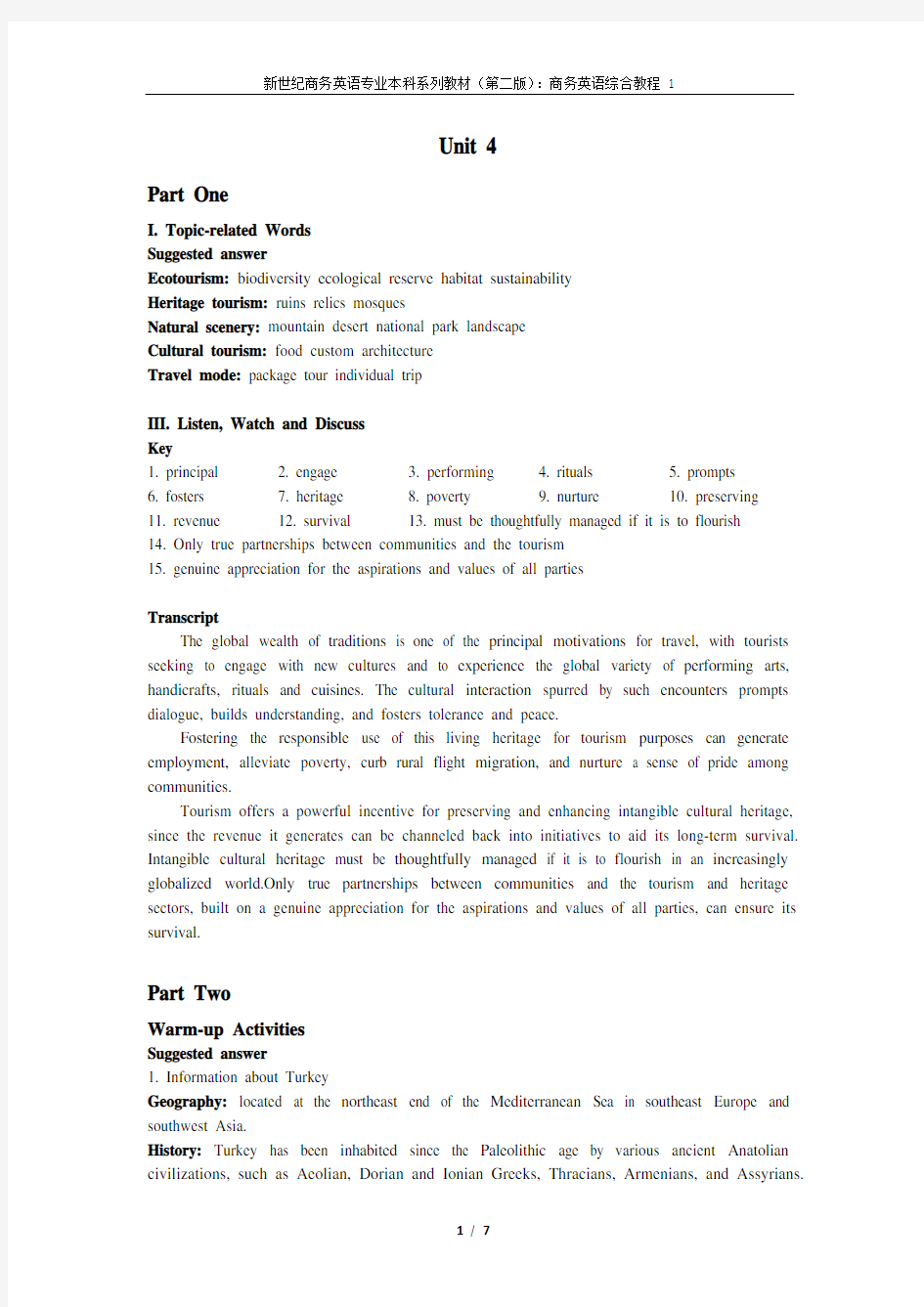商务英语综合教程1-王立非-Unit 4

- 1、下载文档前请自行甄别文档内容的完整性,平台不提供额外的编辑、内容补充、找答案等附加服务。
- 2、"仅部分预览"的文档,不可在线预览部分如存在完整性等问题,可反馈申请退款(可完整预览的文档不适用该条件!)。
- 3、如文档侵犯您的权益,请联系客服反馈,我们会尽快为您处理(人工客服工作时间:9:00-18:30)。
Unit 4
Part One
I. Topic-related Words
Suggested answer
Ecotourism: biodiversity ecological reserve habitat sustainability
Heritage tourism: ruins relics mosques
Natural scenery: mountain desert national park landscape
Cultural tourism: food custom architecture
Travel mode: package tour individual trip
III. Listen, Watch and Discuss
Key
1. principal
2. engage
3. performing
4. rituals
5. prompts
6. fosters
7. heritage
8. poverty
9. nurture 10. preserving 11. revenue 12. survival 13. must be thoughtfully managed if it is to flourish
14. Only true partnerships between communities and the tourism
15. genuine appreciation for the aspirations and values of all parties
Transcript
The global wealth of traditions is one of the principal motivations for travel, with tourists seeking to engage with new cultures and to experience the global variety of performing arts, handicrafts, rituals and cuisines. The cultural interaction spurred by such encounters prompts dialogue, builds understanding, and fosters tolerance and peace.
Fostering the responsible use of this living heritage for tourism purposes can generate employment, alleviate poverty, curb rural flight migration, and nurture a sense of pride among communities.
Tourism offers a powerful incentive for preserving and enhancing intangible cultural heritage, since the revenue it generates can be channeled back into initiatives to aid its long-term survival. Intangible cultural heritage must be thoughtfully managed if it is to flourish in an increasingly globalized world.Only true partnerships between communities and the tourism and heritage sectors, built on a genuine appreciation for the aspirations and values of all parties, can ensure its survival.
Part Two
Warm-up Activities
Suggested answer
1. Information about Turkey
Geography: located at the northeast end of the Mediterranean Sea in southeast Europe and southwest Asia.
History: Turkey has been inhabited since the Paleolithic age by various ancient Anatolian civilizations, such as Aeolian, Dorian and Ionian Greeks, Thracians, Armenians, and Assyrians.
The Persian Empire occupied the area in the 6th century B.C., giving way to the Roman Empire, then later the Byzantine Empire. The Ottoman Turks first appeared in the early 13th century, and gradually spread through the Near East and Balkans, capturing Constantinople in 1453. After the reign of Sultan Suleiman I the Magnificent (1494—1566), the Ottoman Empire began to decline. In the nineteenth century, Turkey was occupied by Russia, but the Turkish War of Independence (1919—1922) resulted in the establishment of the modern Republic of Turkey in 1923.
Politics: Turkey is a parliamentary representative democracy.
Economy: Turkey has the world’s 17th largest GDP by PPP and 18th largest nominal GDP. The country is among the founding members of the OECD and the G-20 major economies. Religion: Islam is the dominant religion of Turkey with 99.8 percent of the population being registered as Muslim.
2. Ancient civilizations
Roman civilization began on the Italian Peninsula as early as the 8th century BC and shifted from a monarchy to a republic and then to an empire. As a highly developed civilization, Ancient Roman has contributed a lot to modern government, law, politics, engineering, art, literature, architecture, technology, warfare, religion, language and society.
Persian civilization is a series of imperial dynasties centered in Persia (Iran), the first of which was established by Cyrus the Great in 550 BC, with the Persian conquest of Media, Lydia and Babylonia.
Byzantine civilization is the continuation of the Roman Empire in the East during Late Antiquity and the Middle Ages, when its capital city was Constantinople (modern-day Istanbul, originally founded as Byzantium). It survived the fragmentation and fall of the Western Roman Empire in the 5th century AD and continued to exist for an additional thousand years until it fell to the Ottoman Turks in 1453. During most of its existence, the empire was the most powerful economic, cultural, and military force in Europe.
Modern historians distinguish Byzantium from ancient Rome insofar as it was centered on Constantinople, oriented towards Greek rather than Latin culture, and characterized by Orthodox Christianity.
The Ottoman Empire, which is also known as the Turkish Empire or Turkey, was an empire founded in 1299 by Oghuz Turks under Osman I in northwestern Anatolia. With conquests in the Balkans by Murad I between 1362 and 1389, the Ottoman sultanate was transformed into a transcontinental empire and claimant to caliphate. The Ottomans overthrew the Byzantine Empire with the 1453 conquest of Constantinople (present-day Istanbul) by Mehmed the Conqueror.
The Neo-Assyrian Empire was an Iron Age Mesopotamian empire, in existence between 911 and 609 BC. Following the reforms of Tiglath-Pileser III in the 8th century BC, Assyria emerged as the most powerful state of the Ancient Near East, eclipsing Babylonia and Egypt. The Neo-Assyrian Empire succeeded the Middle Assyrian period of the Late Bronze Age. During this period, Aramaic was also made an official language of the empire, alongside the Akkadian language.
Text I
Comprehension Check
I. Reading for general ideas
